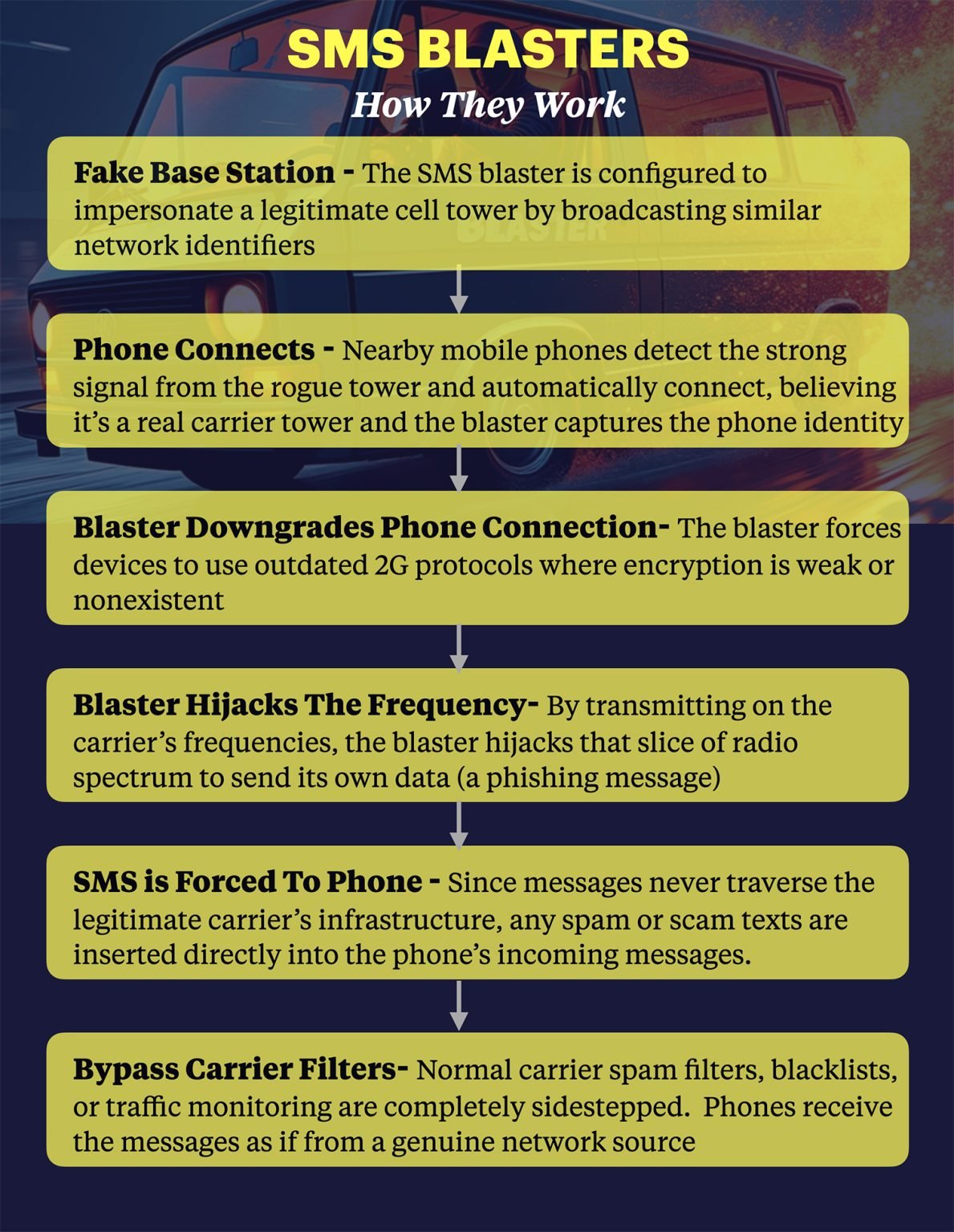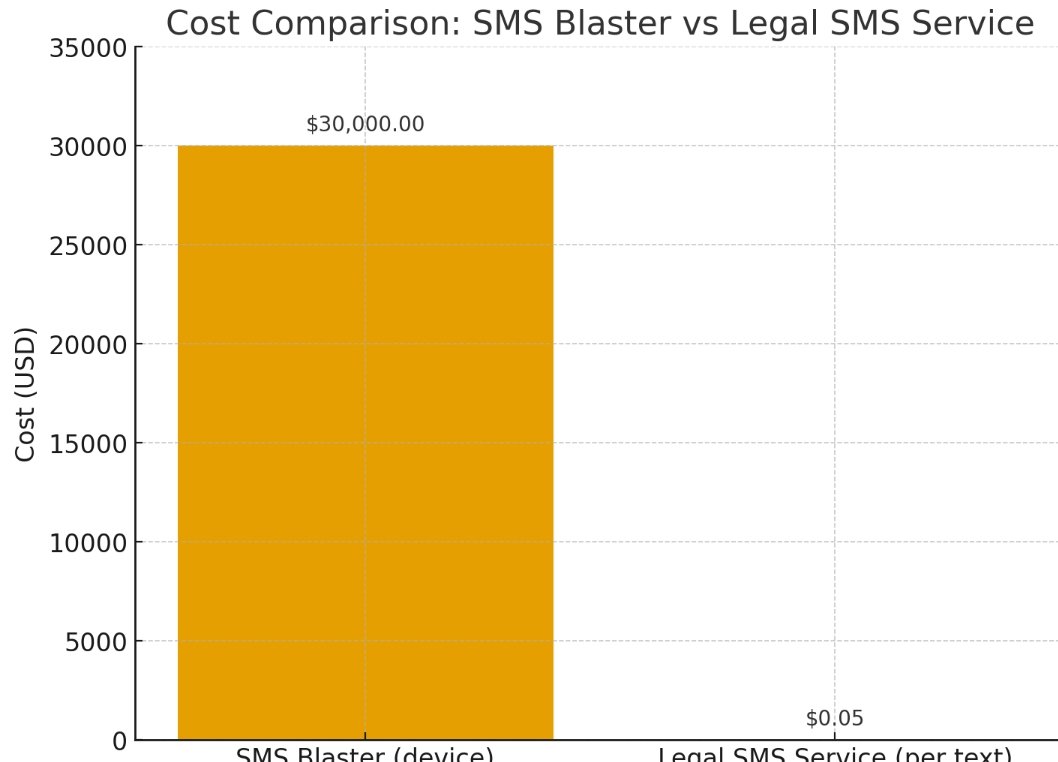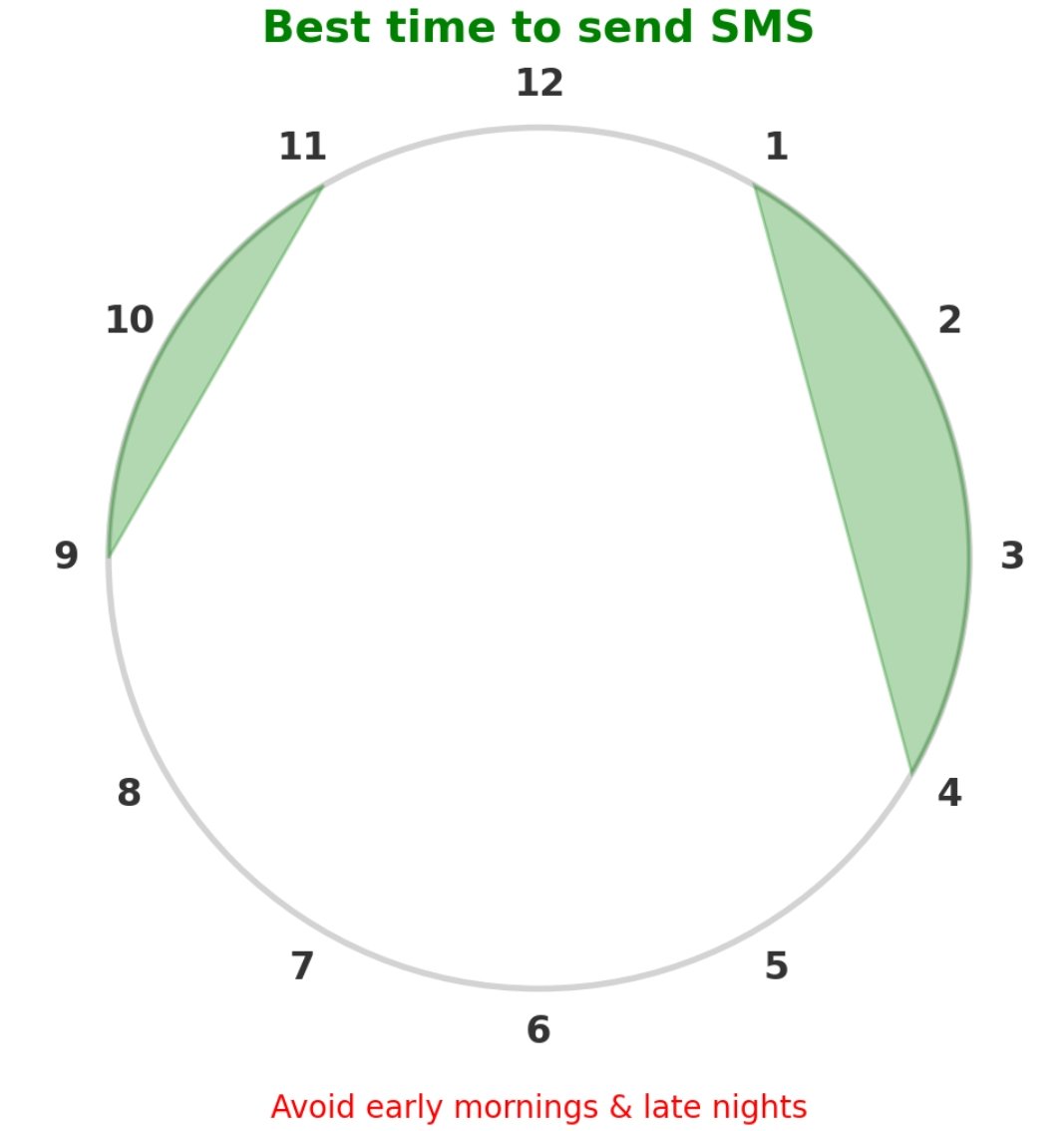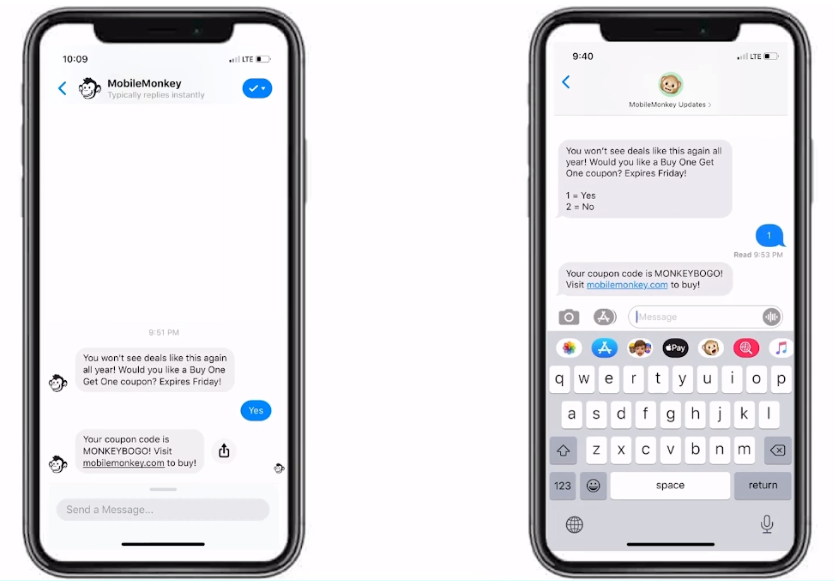In December 2022,Paris police pulled over a van and stumbled upon something alarming. Inside were five men who had already sent over 400,000 scam text messages to people across the city in just one night.
At first, officers thought they had discovered a bomb in the back of the vehicle. Instead, it turned out to be something just as dangerous in the digital world an SMS blaster.
These machines look harmless, but they’re incredibly powerful. Originally designed to help authorities send mass alerts during emergencies, they’re now falling into the wrong hands. Scammers are using them to blast out phishing texts that trick people into handing over bank details, passwords, or personal information.
The Paris case wasn’t an isolated incident. From Bangkok to London, SMS blasters are popping up in cities worldwide, raising big questions: Who’s selling these devices? Why are they so hard to control? And most importantly how can you protect yourself from them?
This article will cover almost everything you need to know about sms Blast softwares/Apps.
What Is an SMS Blaster and How Does It Work?

An SMS blaster might sound like something out of a spy movie, but it’s very real. It’s a device that can push out thousands of text messages to every phone nearby. no phone numbers needed, no mobile plan required.
Instead of going through the regular network, it hijacks the signal that your phone relies on to connect to the world. That’s why it’s become such a favorite tool for scammers.
How SMS Blasters Mimic Miniature Cell Towers
Here’s the clever (and scary) part: your phone is always looking for the strongest signal around. An SMS blaster tricks it by pretending to be a legitimate cell tower.
When the blaster switches on, it broadcasts a fake signal.
Phones in range connect automatically, thinking, “Oh, this must be my tower.”
The blaster then pushes out text messages directly, bypassing the carrier completely.

That’s how hundreds of people in the same area can suddenly receive the exact same scam message whether it’s a fake bank alert, a delivery notice, or a “click here to claim your prize” phishing links.
The Difference Between Bulk SMS Senders and Rogue SMS Blasters
At first glance, SMS blasters might sound like ordinary bulk texting tools used by businesses, but they’re not the same thing at all.
Bulk SMS Senders (legit use):
Companies, schools, or even governments use these services to send updates like your dentist reminding you of an appointment. They go through mobile carriers, which can monitor and block suspicious messages.
SMS Blasters (rogue use):
These devices pretend to be the network itself, so they don’t need your number or your carrier’s approval. If you’re physically nearby, you’re a target. And since the messages never pass through the carrier, there’s nothing the telecom company can do to stop them.
Think of it this way: a bulk SMS sender is like paying to send a package through the post office, while an SMS blaster is like breaking into your mailbox and dropping in a fake letter without anyone noticing.
Real Life Case Studies of SMS Blasters in Action
SMS blasters aren’t just some piece of tech jargon they’re out there in the real world, being used in ways that range from life-saving to downright criminal. Here are a few stories that show just how big their impact can be.
Paris Police Bust: 400,000 Scam Messages in One Night
In December 2022, Paris police pulled over a van and got the shock of their lives. Inside were five men who had already blasted out more than 400,000 scam texts across the city.
The messages looked like they came from a health insurance provider, asking people to click a link and hand over their personal details. At first, officers thought the strange device in the van was a bomb. But it wasn’t explosives it was an SMS blaster, quietly hijacking phones and flooding inboxes with phishing scams.
How Thai Police Used an SMS Blaster to Warn of a Tsunami
Not every story is bad. In Thailand, police once used an SMS blaster for good sending out urgent tsunami warnings to people in the danger zone. Thousands of residents got the alerts instantly, giving them precious time to move to safety.
In that moment, the technology proved its worth. The same tool that scammers abuse to steal money can also save lives when used responsibly.
Fraudsters in Asia and the U.K. Exploiting SMS Blasters for Banking Scams
Of course, criminals have been quick to turn this tech into a weapon.
In Bangkok, one scammer used an SMS blaster from his van to send out a million fake banking texts in a single campaign. His goal? Trick people into entering their login details on phishing sites.
In the U.K., a group built their own blaster and posed as banks and government agencies, sending out thousands of texts designed to steal personal data and drain accounts.
These cases show the two faces of SMS blasters: a tool that can warn entire communities in an emergency, but also a weapon that can target thousands of unsuspecting people at once.
Where Do Criminals Buy SMS Blasters?
You might assume that a gadget powerful enough to hijack phone networks would be hidden deep in the darkweb.
But here’s the shocking truth: SMS blasters are being sold out in the open. With nothing more than an internet connection and a credit card, anyone can order one.
How Much Does an SMS Blaster Cost?
These machines aren’t cheap. A professional SMS blaster usually runs around $35,000 or more. But for scammers, that’s pocket change compared to what they stand to gain if even a small percentage of victims click a link and hand over banking details.
And it’s not just the big, well funded fraud groups. Cheaper DIY versions and kits are floating around online, making it easier than ever for smaller criminal groups to get in on the game.
SMS Blaster Sellers on Alibaba and Other Marketplaces
One of the most surprising places you’ll find them? Alibaba. Yes, the same site where people buy electronics, furniture, or wholesale goods.
Search for terms like “GSM base station” or “SMS broadcaster” and you’ll find machines that:
Cover anywhere from a few hundred meters to several kilometers.
Send tens of thousands of texts per hour.
Can be paired with high-powered antennas for even wider reach.
While many listings claim these are for “testing” or “marketing,” the reality is that the same features make them perfect for mass scams.
SpySolution and Darkwebgroups: Openly Advertising Rogue Tech
Beyond big marketplaces, there are also niche websites that seem almost proud of what they’re selling.
- SpySolution.com shows off machines that can send 100,000 SMS per hour, with ranges up to 3 km. Their site even uses a phishing style text message as an example then tries to cover themselves with a disclaimer saying it’s “up to the buyer to follow the law.”
- Darkwebgroups.com claims their device can blast texts to nearby phones without needing numbers or a carrier plan. In plain English: it bypasses the phone network completely.
It’s wild to see how openly these sites advertise. For regulators, shutting them down is like playing a never-ending game of whack-a-mole.
Why SMS Blasters Are So Hard to Regulate
On the surface, the solution seems simple: just ban SMS blasters and the problem goes away. But in reality, it’s not that straightforward. These devices are tricky to detect, sold across borders, and here’s the kicker they’re also useful in emergencies.
Telecom Providers Can’t Detect or Block Them
Normally, your mobile carrier can spot shady text campaigns because every message has to pass through their system. But SMS blasters don’t play by those rules.
They pretend to be a real cell tower, so the messages never touch the carrier’s network. To your phone, the blaster looks legitimate which means:
- Carriers can’t monitor or block the texts.
- Filtering systems don’t catch them.
- Victims usually have no idea the messages came from a fake tower.
In short: SMS blasters fly completely under the radar.
Different Legal Approaches Around the World
The legal picture isn’t any clearer. Some countries have cracked down hard:
Thailand, for example, has arrested people for running rogue base stations.
Elsewhere, the laws are vague or outdated, making enforcement much harder.
And because these devices can be ordered online and shipped worldwide, a scammer in one country can easily operate in another with weaker rules.
Why Banning Them Outright Isn’t So Simple
Here’s the catch: SMS blasters aren’t always bad. Emergency services sometimes use them to send mass alerts during disasters like floods, wildfires, or tsunamis. In those cases, the ability to reach thousands of people instantly can literally save lives.
That’s why regulators are stuck in a tough spot. Ban them completely, and you take away a valuable emergency tool. Leave them unchecked, and criminals keep exploiting them for scams.
It’s a classic double edged sword useful in the right hands, dangerous in the wrong ones.
How to Protect Yourself From SMS Blast Scams
SMS blasters are sneaky because they bypass normal protections from your mobile carrier. But don’t worry — there are simple steps you can take to make yourself a lot harder to target.
Turn Off 2G to Block SMS Blaster Tricks
Here’s the deal: most SMS blasters rely on old 2G networks, which are much easier to fake than modern 4G or 5G towers.
If you have an Android phone, Google now gives you an option to switch off 2G completely. Once that’s off, your phone won’t connect to a fake tower trying to trick you.
👉 To check: go to Settings → Network & Internet → Mobile Network → Preferred Networks and look for “Disable 2G.” (It’s not on every device yet, but it’s becoming more common.)
How to Spot a Scam Text Before It Gets You
Even if one slips through, most phishing texts give themselves away if you know what to watch for:
- Urgent tone: “Your account is locked act now!”
- Weird links: Short URLs or addresses that don’t match the real site.
- Too good to be true offers: “You’ve won a prize!” (Spoiler: you haven’t.)
- Fake identities: Messages pretending to be from your bank, a delivery service, or even the government.
💡Quick tip: If a text is pushing you to click a link or share personal details, that’s your red flag.
What to Do If You Get a Scam SMS
- Don’t click anything not even “unsubscribe.”
- Block the number on your phone.
- Report it in many countries, you can forward it to a scam-report number (like 7726 in the U.S. and U.K.).
- Delete the message so you don’t accidentally open it later.
- If you already clicked and entered details, call your bank right away and change your passwords.
Questions You may also ask?
Is SMS Blasting Illegal?
On its own, SMS blasting isn’t illegal. It’s often used in perfectly legitimate ways, like sending out emergency alerts or marketing messages to people who’ve chosen to receive them. The trouble starts when it’s used for scams, spam, or messages sent without consent.
That’s where the law comes in. In the United States, the Telephone Consumer Protection Act (TCPA) makes it illegal to send unsolicited marketing texts. In Europe, the GDPR requires businesses to get clear permission before contacting people by SMS. Breaking these rules can lead to heavy fines and in some cases, even criminal charges.
So while the tool itself isn’t against the law, using it irresponsibly or dishonestly almost always is.
Is SMS Blasting Expensive?
Yes, SMS blasters are very expensive. Unlike normal bulk SMS services, which charge just a few cents per text, these machines cost tens of thousands of dollars.

For example, some high-end models are listed at around $27,000 to $37,000 on sites like SMSBroadcaster.com. Even basic versions show up for about $11,000 on Alibaba.
The reason for the high price is simple: these devices don’t send messages through normal carriers. Instead, they mimic a cell tower, which requires specialized and powerful hardware.
Meanwhile, businesses that want to send messages legally don’t need these machines at all. Platforms like Alibaba Cloud SMS let you send texts for as little as five cents each, making them far more affordable and completely above board.
What is the best time to send SMS blasts?
The best time to send an SMS blast is when people are relaxed enough to actually read it not half-asleep, not rushing to work, and not winding down for bed.

A sweet spot for most audiences is mid-morning (around 9–11 AM) or early afternoon (1–4 PM) on weekdays. People have usually cleared their inboxes and are more open to checking their phones. Midweek Tuesday to Thursday often works better than a Monday (too busy) or Friday (already thinking about the weekend).
One golden rule: never text late at night or too early in the morning. Most folks see that as spammy and intrusive. A safe window is between 8 AM and 9 PM in the recipient’s local time.
Every audience is different, so the smartest move is to test a couple of times and see when people respond best. Start with mid morning, measure the results, and adjust from there.
Conclusion
SMS blasters are a perfect example of technology’s double-edged nature. In the right hands, they can save lives by sending urgent alerts during disasters. In the wrong hands, they become a powerful tool for scammers, able to hit thousands of phones with phishing messages in just minutes.
The good news? You can protect yourself. Keep your phone updated, think about turning off 2G if your device allows it, and always pause before clicking on links in unexpected texts. If you spot a suspicious message, report it every report helps stop scammers from spreading further.
The key is staying alert. A few simple steps can make a big difference, keeping you one step ahead of fraudsters while still benefiting from the legitimate uses of this technology.

We focus on researching and publishing clear, reliable information about online activities. By explaining how different formats and tricks work, we aim to educate our audience and support safer internet use




